For a half-century the Ford Mustang has been an acquired taste--one that many people acquired instantly, while others never did. Compared to a European coupe with similar performance, it was rude, crude, and far less expensive. It was clearly American.
But when Ford redesigned the Mustang for the 2015 model year, it decided to aim higher and wider. It sought to tweak the styling and boost refinement to appeal to people who would never have bought a Mustang before, even people who were not Americans, while still giving the cars' many fans what they want.
Is this an achievable goal? Or is a car that strives to appeal to two very different audiences destined to make neither happy? With these questions in mind, I haven't pitted the Mustang against the obvious choice, its archrival the Chevrolet Camaro. (This would make limited sense even with a different approach, as the Camaro is being entirely redone for 2016.) Instead, I'll be comparing the Mustang GT to the similarly V8-powered Audi RS 5. The Audi costs over $30,000 more. Can the Mustang hope to measure up?
An unfortunate disclaimer: I had an accident in the Audi the very first day, so my experience in the car, while enough to get a sense of what it's like to drive, was limited. Driving on a dark drizzly night, I noticed a second too late that the crossover ahead of me had stopped. Strong brakes reduced the impact to a tap, but mismatched bumper heights left absorption to the plastic grille and the radiator immediately behind it.
Lesson 1: With ride heights much more likely to differ than a generation ago, bumpers are much less likely to do their job. Somehow this hadn't crossed my mind before.
Lesson 2: Forward collision warning, optional on both the Mustang and the RS 5, but not on the latter test car, can be very good to have.
These lessons shared, on with the comparison.
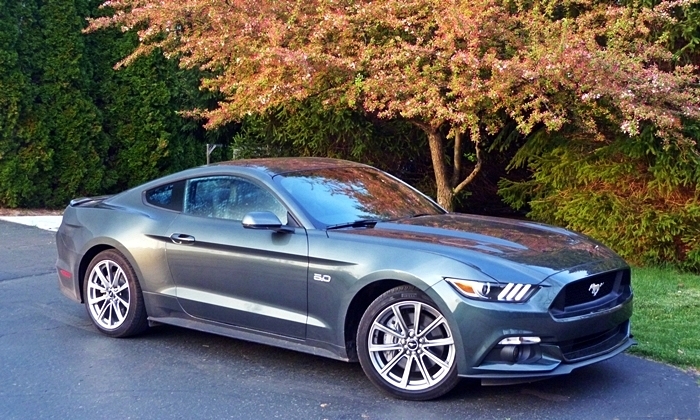
Muscular body sides. The wheels are a good match. more Mustang photos
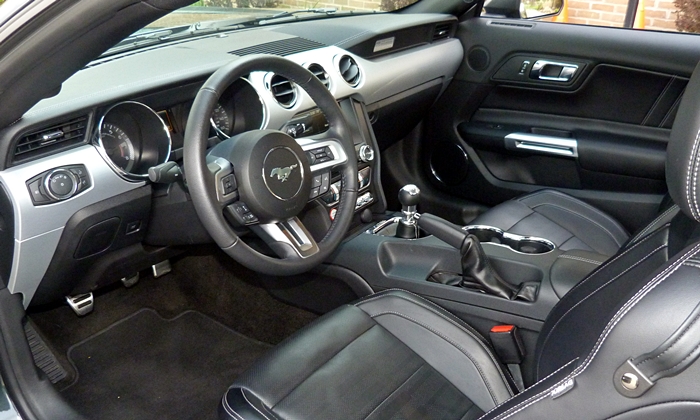
The interior also effectively combines current Ford design with traditional Mustang flavor.
| |
Compared to the A5 / S5 |
| Price or payments |
 Better
Worse
Better
Worse
|
Die-hard Mustang fans have no desire for any other car. But for non-fans the primary appeal could be the performance of a V8-powered European coupe at a far lower price.
Which is not the same as a low price. While the 2015 Mustang lists for as little as $24,625, this is with a 300-horsepower 3.5-liter V6. Add $1,500 for the new 310-horsepower 2.3-liter turbocharged four-cylinder engine and some additionial standard features. Add another $7,000 for the Mustang GT with its 435-horsepower V8, raising the ante to $33,125.
Then there are options. A Premium model with upgraded interior trim, heated and cooled leather-upholstered seats, automatic climate control, and the MyFord Touch infotainment system adds $4,000. An equipment group with a Shaker audio system, blind spot warning, and memory seats adds another $1,795. Adaptive cruise control with forward collision warning adds $1,195. Nav adds $795. The tested car was fitted with all of these options.
Maybe you care more about performance than such luxury features. A Performance Package with upgraded tires, steering, suspension, and brakes is highly recommended if you'll be tracking the car, and maybe even if you won't be. A downside beyond its $2,495 price: this package includes black wheels that few people find attractive on the car. Recaro seats which delete all power adjustments, the heating, and the cooling add $1,595. If you're getting the Premium model, this might seems like too much to trade for additional lateral support.
For sake of comparison let's add all save the Recaros to a Mustang GT, yielding a total of $43,405. As I said, the Ford's price isn't exactly low. But then there's the Audi's: $78,825.
The additional $35,000 for the Audi does include some additional features. You can't get the RS 5 with a manual transmission or with two-wheel drive. The dual-clutch automated manual and all-wheel-drive tend to be valued about $2,750 above the Mustang's more basic drivetrain. The Audi when so loaded up also includes some features not offered on the Mustang, including a power-venting glass roof panel, a retractable rear spoiler, an active rear differential, active steering, obstacle detection at both ends, four-way power lumber on both seats, and a smattering of other things. These justify another $5,500 of the price difference, leaving a still substantial $27,000. A $43,000 Ford Mustang GT might seem a bargain in comparison.
| Powertrain performance |
 Better
Worse
Better
Worse
|
A bargain is only a bargain if nothing of substance is given up. Can the Mustang GT deliver the performance of the RS 5?
In a straight line on a dry road, absolutely. The Audi's engine has a few more horsepower at its peak, 450 vs. 435. But it's a much smaller V8, 4.2 vs. 5.0 liters, so this peak is far higher--a lofty 8,250 rpm, vs. a much more accessible 6,500 in the Mustang. While there's absolutely something thrilling about a V8 that can rev to 8,500 rpm without running out of breath or flying to pieces, on public roads you're not going to spend much time there. Drop down to 4,000 rpm or so and the Ford 5.0 is far stronger, with 400 pound-feet of torque to the Audi 4.2's 317.
The Audi does have twice as many driven wheels to help transfer power to the pavement at low speeds, but this is counteracted by a couple hundred extra pounds of curb weight and overly tall gearing (the first of seven ratios is good for 40 mph). The upshot: magazine tests report zero-to-sixty runs in the 4.5-second range for both cars. And in real-world driving the Mustang feels considerably stronger, as its power is always RIGHT THERE.
Frankly, if midrange torque is your thing then the Audi S5 is a better way to go than the RS 5. Though its supercharged 3.0-liter V6 is rated for "only" 333 horsepower, acceleration times just a few tenths behind the RS 5's and the Mustang's suggest that this figure is very conservative. The supercharged V6 also churns out more torque than the high-winding V8 at a lower rpm. When you first dip into the throttle, it delviers a more solid shove. Want a manual transmission, for a more thorough connection to the car? You can have one with the S5. Plus the S5 is about $13,000 less expensive than the RS 5, and so only $21,770 more than the Mustang before adjusting for feature differences, and a mere $16,000 more afterwards.
So why would anyone bother with the RS 5? Well, the supercharged V6 might deliver sufficient thrust, but it adds little to the subjective experience. There's no song, no zing as it revs. In comparison, the RS 5's V8 sounds and feels magical. The caveat: you have to work the shift paddles to rev the bejesus out of it to extract this magic.
The Mustang GT's V8 combines the best traits of both engines. It has low-end guts to match the supercharged six, and then some. Plus it has soul to spare. You can't rev the 5.0 as high as you can the RS 5 engine--for this wait for the upcoming GT350. But it spins higher than the S5's engine, and it rumbles then roars intoxicatingly the whole way up. Unlike in the RS 5, which feels tame when driven casually, you're constantly aware of the monster lurking beneath the long bulging hood. Refinement isn't quite on the same level as the RS 5's V8, but it's not far off. This isn't the sort of crude V8 Detroit used to churn out by the millions. Thoroughly modern, it's a match for Europe's best.
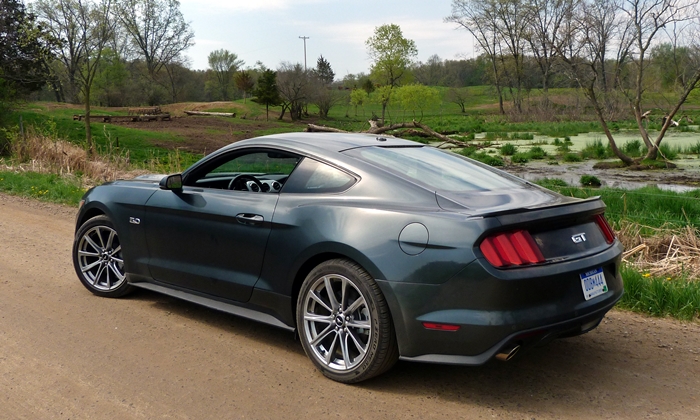
Rear panel maintains a stylistic connection with past Mustangs.
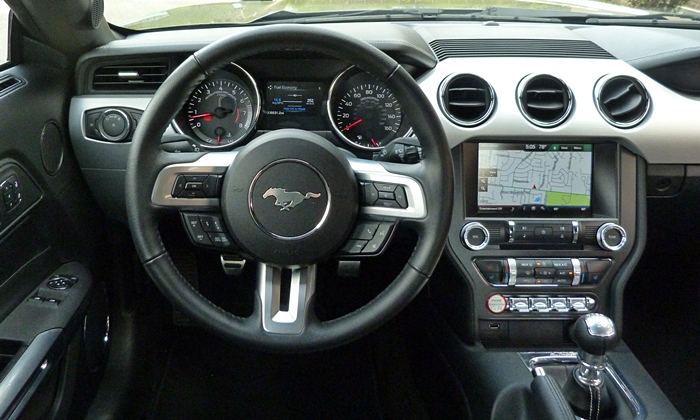
Plenty of buttons, mostly logical. Toggles at the base of the center stack select drive modes.
| Handling |
 Better
Worse
Better
Worse
|
I wavered on whether to list handling among the reasons to buy a Mustang. I don't really care for how either car handles. On a curvy road I much prefer a lighter, more compact, and more agile machine. The 188-inch-long, 75-inch-wide Mustang GT weighs nearly two tons. The RS 5 isn't quite as large, but owing to German overengineering and its additional drivetrain bits you can drop the "nearly." Especially on public roads both feel at least as heavy as they are. And the Mustang, with its long hood, increased width, and smaller windows, feels large as well.
But if we limit our view to cars of the Mustang's size and weight its handling seems more of a strength. Ford finally chucked a live rear axle in favor of an independent rear suspension, so the new Mustang maintains its composure much better on uneven pavement. With the standard suspension, the GT's nose bobbles some over dips. The Performance Package should attentuate this bobbling.
Maintaining composure is something performance-oriented Audis have long done well. The problem is, the RS 5 maintains its composure to a fault. Even with an active rear differential it takes a lot of throttle to alter the attitude of the chassis, and even then not by much. With any sort of speed in curves understeer predominates, as it always has in these nose-heavy cars. With the V8 mounted ahead of the front axle, about 57 percent of the car's weight rests on the front tires. If you can't really push the RS 5, and you rarely can on public roads, then it drives much like a garden variety A5. Perfectly pleasant, but little in the way of excitement.
In comparison, the Mustang feels far more lively and involving. It's also a little nose-heavy, with a 54/46 weight distrbution, and also understeers (resists turning) moderately in hard steady state cornering. But you feel more through its more progressively weighted steering wheel, and you can counteract that understeer with just a touch of throttle. For somewhat more balanced and agile handling, get the four-cylinder.
Go beyond a touch of throttle with the wheel turned and the stability control in any mode save the default, and be ready for the rear end to step out. The more you dip into the throttle, the farther out the rear end will step. As long as you don't go too far, a little countersteering will bring the tail back into line. This sort of dynamic behavior is what leads most driving enthusiasts to prefer rear-wheel drive despite the all-weather traction benefits of all-wheel drive.
Yet as much fun as I had driving the Mustang GT (a lot), I never could quite connect with it. Its steering and handling have improved dramatically, yet I continue to find the handling more intuitive in GM's and Chrysler's rear-wheel drive cars. The feedback and axes of rotation in the Mustang aren't quite where I'd like them to be. I suspect I'll prefer the handling of the new Camaro.
| |
Compared to the A5 / S5 |
| Fuel economy |
 Better
Worse
Better
Worse
|
The performance of these cars is not without an obvious tradeoff. In EPA tests, the Mustang GT manages only 15 mpg city, but 25 mpg highway, with the manual transmission. With the optional six-speed automatic, the car can go a mile farther per gallon in the city. The Audi rates a little better in the city, but worse on the highway: 16/23.
In my real-world suburban driving, the Mustang's trip computer most often reported averages in the 16-17 range. With a light foot I could nudge the average over 20, and even as high as 24, but what's the point of driving a Mustang GT like you would (or at least should) a Prius? On a 70-mph highway, with the big V8 spinning under 2,000 rpm in top gear, the trip computer reported a fairly impressive (for such a large, powerful engine in a fairly heavy car) 28 mpg.
But if you want decent fuel economy in either car, you'll have to ditch the V8. The new EcoBoost four-cylinder achieves 22/31 with a manual transmission and 21/32 with the automatic. The Audi manages similar figures with a 220-horsepower 2.0T four-cylinder engine, but 17/26 with the manual and 18/28 with the automated dual-clutch transmission and the S5's supercharged V6.
| Materials & workmanship |
 Better
Worse
Better
Worse
|
The new Mustang has a much nicer interior than any previous Mustang, but Ford didn't go quite far enough. While most interior panels are worthy of the car's price and brash character--I can forgive the hard plastic center console--the plasti-chrome dials and toggle switches have a Revell look and feel. A little real metal (or at least more convincing polymers) would go a long way with these.
The constrasting stitching on the top of the instrument panel, door panels, center armrest, and seats is a nice touch. But why then include molded-in fake sticthing on the hard plastic panels that frame the center stack? I can envision what might have happened. The designers wanted these panels to have real stitching, but finance objected. To hit a cost target, fake molded-in stitching was substituted. But it isn't a contracting color like the real stitching on the other interior parts and it appears as fake as it is. Ford should have either used real stitching or done without stitching entirely on these panels. Real stiching, maybe even real stitching and leather, on the handbrake grip would also be welcome.
For at least a decade Audi interiors have served as the benchmark for the entire auto industry. While some of the switches in the RS 5 also struck me as overly plasticky, overall its interior looks and feels at least $5,000, perhaps $10,000 more expensive than the Mustang's, justifying another chunk of its higher price.
If Ford could spend just a little more money on the Mustang's interior it could eliminate the only remaining parts that look and feel unworthy of the car. Spend a grand or two more and they'd have the equivalent of the Audi, and perhaps the Mustang-based Lincoln that has sometimes been rumored.
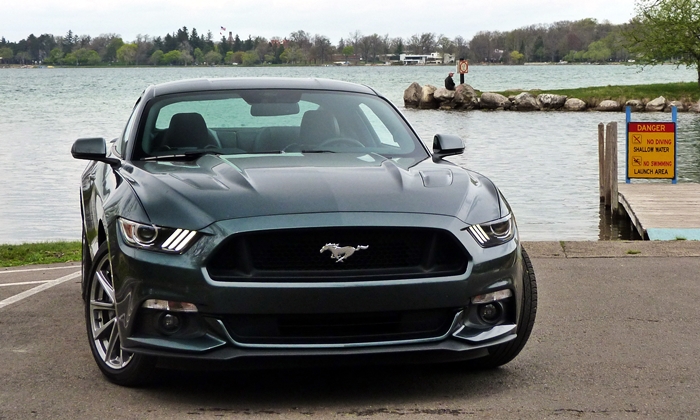
Bold face. Clearly identifiable as both a current Ford and a Mustang. Sculpted hood suggests power.
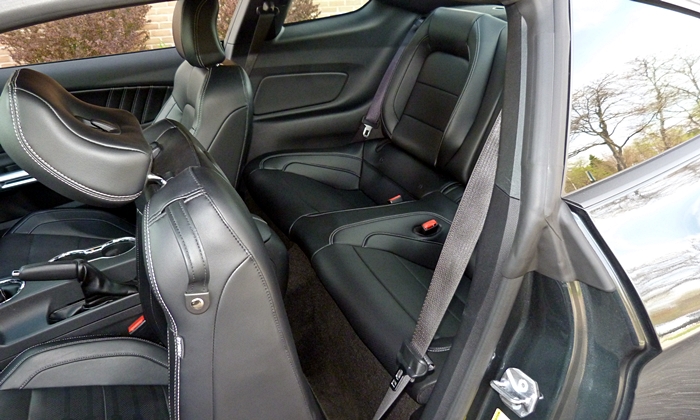
The Mustang's back seat is even less adult-friendly than the Audi's.
| Rear seat room & comfort |
 Better
Worse
Better
Worse
|
This "why not" should not come as a surprise. Neither the Mustang nor the Audi has much rear legroom. Plus in the Mustang my head was pressed against the rear window, and I'm only 5-9. The Mustang coupe's rear seat is viable only for people up to 5-6 or so in height. The Audi has a little more rear headroom. As does the Mustang convertible.
If you will be putting people into the rear seat of the Mustang, you should turn off the "easy entry" feature. When it's activated, this feature automatically motors the seat backward when the engine is shut off, reducing rear legroom to near zero. I was nearly trapped when I turned the engine off while sitting in the back seat to take photos.
If you want a V8-powered coupe with a roomy rear seat, get a Dodge Challenger.
Both the Mustang and the RS 5 do a better job of transporting luggage than rear seat passengers. Both trunks have about as much capacity as that of the average compact sedan.
| Driving position & visibility |
 Better
Worse
Better
Worse
|
Historically, the Chevrolet Camaro has been plagued with a low driving position and bunker-like outward visibility, while the Mustang has been more practically packaged. With the 2015, Ford has taken a step in the direction of the Camaro. You still sit well above the instrument panel, with the long hood bulging upward to fill much of your forward view (an essential part of the car's character). But the windows, especially the side windows, seem overly small. Larger side windows would improve outward visibility while reducing the perceived bulk of the car. The Audi's interior isn't as roomy, yet it feels more open.
| |
Compared to the A5 / S5 |
| Front seat support & comfort |
 Better
Worse
Better
Worse
|
The Audi RS 5's front seats are a little on the firm side, but I find them comfortable, and they provide very good lateral support.
As mentioned when discussing pricing, you have a choice of two seats in the Mustang. The standard seats, in the main car I tested, are broader and cushier than those in the Audi, but still provide good lateral support. Headrests that adjust fore-aft are a welcome touch uncommon at the base car's price level. Sadly, power seat recliners didn't make the cut, perhaps because they're hard to execute in conjunction with seats that flop forward for people entering steerage.
The Mustang's optional Recaro seats feel more like those in the Audi, but large drivers will find them overly tight and unyielding. Plus, as noted earlier, they come with no heating, no cooling, and no power adjustments. If you'll be driving the Mustang frequently on the track or very challenging roads, they could be worth the sacrifice. Most people will be happier with the looser fitting, more luxurious standard front seats.
| Ride smoothness |
 Better
Worse
Better
Worse
|
With the standard suspension, the Mustang GT hits some bumps firmly (with a loud clomp), but usually rides well for a performance-oriented car. I've only driven a Mustang with the Performance Package on a track, but it should ride more firmly. As does the Audi, which while certainly not a hardcore machine will push the edge of livability for some drivers.
| Quietness |
 Better
Worse
Better
Worse
|
Quietness has not been an attribute of past Mustangs. The new one is far more refined. When you're cruising at a steady speed it's not too much louder inside than the Audi, which is luxury-car quiet. At 40 mph either car feels like it's barely moving. Neither should prove tiresome in long-distance highway driving.
The Mustang's engine roars when accelerating, but as soon as you level off it hushes up, with no hint of an annoying drone.
| Exterior styling |
 Better
Worse
Better
Worse
|
With the original pony car's latest redesign, Ford has dialed back the retro, but has retained enough traditional cues that the car is clearly a Mustang. Overall the combination of the previous generation Mustang and the typical Asian luxo-performance coupe should retain fans while broadening the car's appeal. The massive, bullet-like nose effectively communicates the car's power. In comparison, the rear quarters look a little weak. Some critics feel that the upper body appears disproportionately small. But during my week with the car people constantly told me how much they loved the look of it. The combination of the dark green paint and the ten-spoke 19-inch wheels didn't hurt.
But the Audi coupe's exterior is both more tastefully restrained and more stunning, a tough combination to pull off. Its proportions approach perfection despite the car's front-wheel-drive basis. Sleek, quiet, and obviously powerful (to anyone paying the slightest attention), it's Teddy Roosevelt's mantra in automotive form.
The new Mustang is so good that I wish they'd put a little more money into interior materials, especially the buttons, knobs, and switches. I also wish the chassis could be tuned to deliver more intuitive responses to steering inputs. As it is, I didn't quite connect with the car. It doesn't help that it's much larger and heavier than I tend to prefer.
All of this said, the new Mustang is an achievement. There's still plenty of traditional Mustang flavor and straight-line performance, but the car no longer seems crude and juvenile compared to Asian and European coupes. Instead, it delivers both the refinement people expect from an import-brand coupe with the visceral thrills that have long been a Mustang strength. The Audi might still be prettier and more sophisticated, a tailored suit rather than designer jeans, but it remains aloof and fails to engage the driver. The Mustang is much more fun.
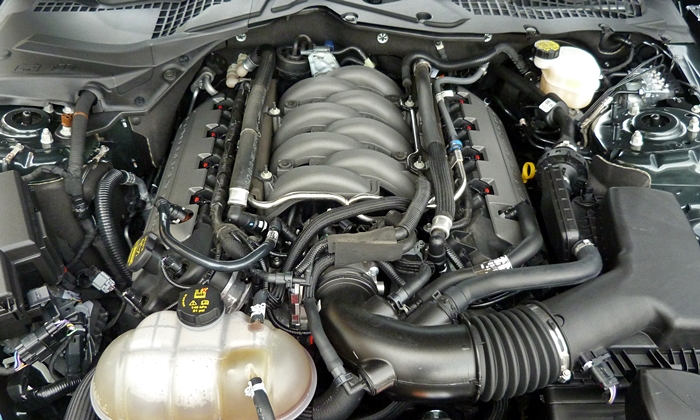
The best-looking part of the Mustang is under the hood. Even under the engine cover.
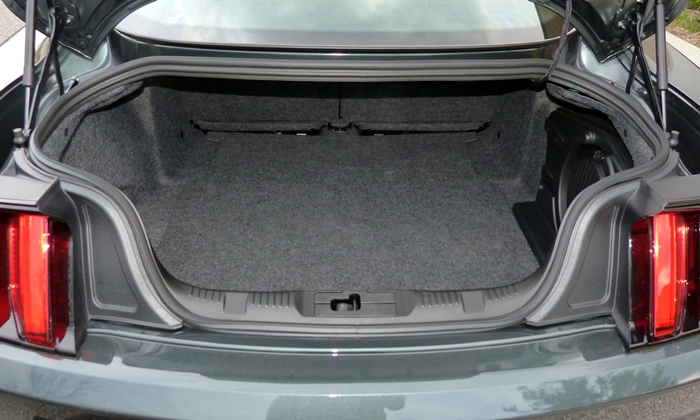
This isn't a tiny roadster. Plenty of space for two people's luggage.
See more 2015 Ford Mustang photos
Ford and Audi each provided an insured car with a tank of fuel.











